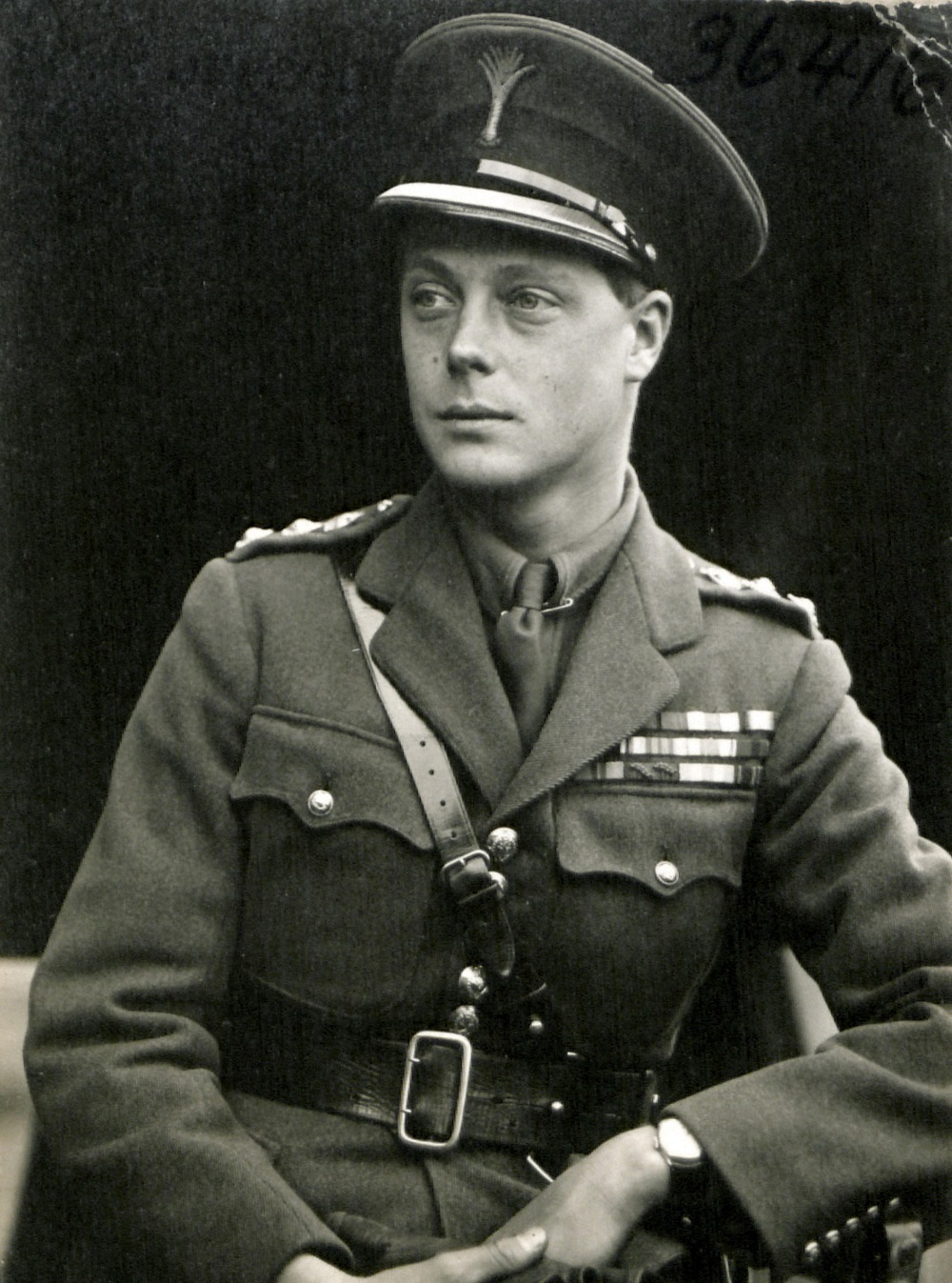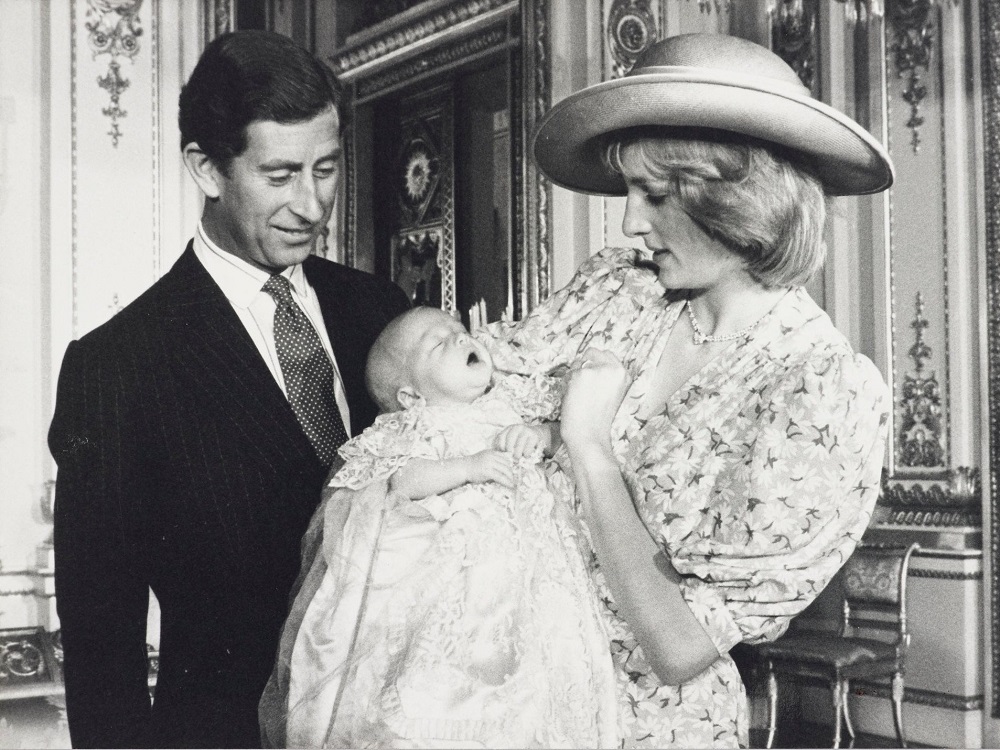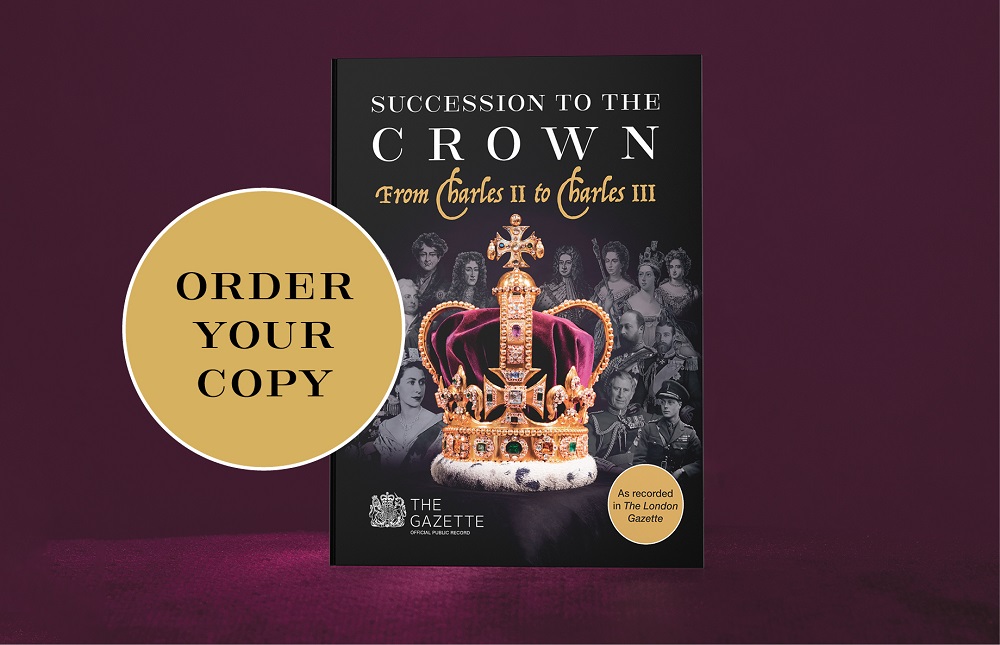Demise of the Crown: #27: Death in France

As the official public record since 1665, The Gazette has been recording the deaths of monarchs for over three centuries. As part of our ‘Demise of the Crown’ series, historian Russell Malloch looks through the archives at The Gazette’s reporting of the deaths of Edward VIII, Wallis, Duchess of Windsor, and Diana, Princess of Wales.
On two occasions, a demise of the crown occurred during the lifetime of The Gazette that did not involve the death of the monarch, as James II left the realm during the revolution of 1688, and Edward VIII abdicated in 1936. Both kings expired in exile in or near the French capital, as James died at St Germans in 1701, and his remains were interred in France, while Edward’s body came back to England.
Two other royal ladies died in Paris, and were buried in English soil, with services being organised at Windsor for Wallis, Duchess of Windsor, and at Westminster Abbey for Diana, Princess of Wales.

Duke of Windsor
The former King Edward VIII, now Duke of Windsor, died at home in Paris on 28 May 1972, a few days after the Queen visited him during a state visit to France. His remains were flown to RAF Benson in Oxfordshire, where they were met by the Queen’s cousin, the Duke of Kent, and carried by an air force bearer party to the chapel on the base, where the coffin lay overnight with four RAF personnel standing guard.
The duke’s casket was then taken to St George’s Chapel, where the catafalque was set in the nave on a raised platform that was erected close to the tomb of his mother and father. The coffin was draped with the duke’s standard, and lay in state for two days before it was moved to the Albert memorial Chapel in advance of the funeral service on 5 June.
The duke is reported not have wanted a state funeral, perhaps for the reasons given in his memoir about his father’s death. The coffin was carried into the quire by a bearer party of the Welsh Guards, of which regiment the duke was the colonel from 1919, and the colonel-in-chief while king in 1936. Three cushions of ensigns were carried in the procession, by Major-General Peter Gillett, the secretary of the Central Chancery of the Orders of Knighthood (Gazette issue 44658), Colonel Vivian Wallace of the Welsh Guards, and Colonel David Hargreaves of the Grenadier Guards. One cushion displayed a field-marshal’s baton, which the Duke of Connaught, as the senior field-marshal, had delivered to the King at Buckingham Palace in May 1936. Another carried his insignia of the Garter, of which he had been a member since 1910, and in respect of which his investiture in 1911 was the last of the order’s ceremonies to be reported in The Gazette (Gazette issue 28507).
No pall bearers or ordinary officers of arms took part, and all of the family members wore morning dress, without any Garter star or other insignia, but there were royal touches to the ceremonial, as the state trumpeters of the Household Cavalry sounded the Last Post and Reveille; the service was conducted by Launcelot Fleming, the dean of Windsor (Gazette issue 45418); the blessing was pronounced by the archbishop of Canterbury, and Garter king of arms proclaimed the style and titles of the last man to have been emperor of India.
By the time the Duke of Windsor died, The Gazette had long since stopped publishing the directions that governed court and general mourning, except in the case of a demise of the crown. The royal establishment continued to observe such events, and members of the royal family were sent personal letters by the Lord Chamberlain’s Office, which explained what would happen. The document that was sent to the duke’s godson Gerald Lascelles, for example, stated that “The Queen commands that the court shall wear mourning from to-day, Sunday, May 28th, up to and including Saturday, June 10th, 1972, for His Royal Highness the Duke of Windsor, Her Majesty’s uncle”. On the following day, the end of the mourning was brought forward to 5 June, as that had been settled as the date of the funeral.
The mourning notice for the former King provides a reminder of the problems that could arise in deciding who to invite to funerals, as the older brother of Gerald Lascelles, the Earl of Harewood (who was George V’s first grandchild, and the sixth in the line of succession to the crown when he was born) recalled that “Perhaps for me the saddest public result of my divorce was that I was not asked to go to his funeral at St George’s, Windsor, where nearly forty years before I had watched him bow at his own father’s funeral.”₁
There was then a private interment at Frogmore, where the stone was inscribed with the duke’s Windsor title, but also as “King Edward VIII 20th January – 11th December 1936”. As was usual in these circumstances, the proceedings were an intimate family occasion. The Queen was joined by the Prince of Wales, the Dukes of Beaufort, Edinburgh and Kent and the Earl Mountbatten of Burma, while the Duchess of Windsor was accompanied by two personal friends, the Countess of Dudley, and Brigadier Douglas Greenacre of the Welsh Guards, who became the late King’s equerry in 1924 (Gazette issue 32987). The burial was also witnessed by the duke’s personal doctor Arthur Antenucci, who signed the death bulletin that appeared in The Gazette (Gazette issue 45688), and by his comptroller, John Utter, whose services to the Queen’s uncle were acknowledged by being invested as an honorary commander of the Victorian Order (CVO) at Buckingham Palace in December 1972.
Wallis Simpson
In terms of managing royal funerals, the loss of the consorts of two Princes of Wales in France gave rise to matters of protocol that were far more difficult to deal with than the Lascelles divorce.
Wallis Simpson had married the Duke of Windsor in June 1937, but she was never granted the right to use the prefix Royal Highness and was not treated as an ordinary member of the royal family, while Diana Spencer was also denied the royal prefix one year before she died after divorcing the future King Charles III.
The remains of both consorts were returned to England, with one being laid to rest beside her husband at Frogmore, while the other was interred in the grounds of her ancestral home in Northamptonshire.
As happened in 1972, after the demise of the Duke of Windsor, the remains of Wallis Simpson were flown to RAF Benson and later conveyed to St George’s Chapel, where the funeral service was performed on 29 April 1986. The coffin was not draped with a flag as it was carried by a bearer party of Welsh Guardsmen, a measure that recalled the Duchess of Windsor’s husband’s connection with the regiment.
The ceremony was attended by the Queen and the Prince of Wales, and by personal friends, including the widow of Fruity Metcalfe, who became the prince’s equerry in 1922 (Gazette issue 32735), and was his best man when he married Mrs Simpson. Michael Mann, the dean of Windsor and register of the Order of the Garter, officiated at the service, and the blessing was given by the archbishop of Canterbury, before the coffin was taken to Frogmore.
The contents of the Paris home of the Duke and Duchess of Windsor were due to be sold by Sotheby’s in New York in September 1997, but the auction was postponed because of the death of Diana, Princess of Wales, in a car crash in Paris, and did not take place until February 1998. The sale included many items that incorporated the emblems of, or were otherwise associated with, the Order of the Garter, including the banner that hung over the duke’s stall while he was Prince of Wales. It also included the certificate he received after being mentioned in General Sir Douglas Haig’s despatch of April 1916 during the first world war as a captain in the Grenadier Guards (Gazette issue 29623), and his portrait in the uniform of colonel-in-chief of the Welsh Guards.

Diana Spencer
The men of the Welsh Guards formed a bearer party a decade later, after the death of the Princess of Wales in Paris in August 1997, an event that led to an unprecedented wave of public mourning for the loss of a member of the royal family, and to exceptional changes being made to royal protocol and procedures.
Lady Diana Spencer had married the heir apparent to the crown in St Paul’s Cathedral in July 1981, but the couple divorced 15 years later and The Gazette reported the letters patent of August 1996 that denied the Princess of Wales the right to use the prefix Royal Highness (Gazette issue 54510). The Gazette also announced the steps that were taken in 1997 to terminate her role as colonel-in-chief of the Princess of Wales’s Royal Regiment, and the Light Dragoons, and to appoint the Queen of Denmark and Princess Margaret in her place (Gazette issue 54745).
After the accident in Paris, the remains of the princess were flown to RAF Northolt, and the Queen spoke about the extraordinary and moving reaction to her former daughter-in-law’s death. Arrangements were made for a funeral procession in London, and for the main service to be held in Westminster Abbey on 6 September 1997.
The coffin was placed on a gun carriage under the care of the Royal Horse Artillery, with an ermine bordered royal standard. There were no military bands or music, and no pall bearers, but instead ten men of the Welsh Guards accompanied the casket on its journey through London, and provided a reminder of the work the regiment did for the Duke and Duchess of Windsor.
The cortege reached the gates of Buckingham Palace where, in a significant departure from protocol, the Queen bowed her head as the gun carriage moved past. The solemn procession was then joined at St James’s Palace by the Prince of Wales and his sons, the Duke of Edinburgh, and the princess’s brother, Lord Spencer, as well as by about 500 members of charities who had benefited from her work. Once again, the procedures were altered, and after the royal remains were set at the crossing in Westminster Abbey the Queen herself placed a wreath beside the catafalque.
After the abbey ritual, during which Elton John played a version of the song Candle in the Wind, the coffin was driven to the princess’s home at Althorp near Northampton and buried in a mausoleum on an island in an ornamental lake on the Spencer estate. This was the first time since The Gazette began in the 1660s that the consort of a prince of Wales had not been interred in a royal setting since 1821, when George IV’s wife, Caroline of Brunswick-Wolfenbüttel, was laid to rest in her family’s vault in Germany.
The New Year honours list of 1998 included an appointment as lieutenant in the Victorian Order (LVO) for Martin Neary, the organist of Westminster Abbey, for his services at the funeral (Gazette issue 54993), and a silver Royal Victorian Medal for Sidney Clarke, a chauffeur with Leverton and Sons, the funeral directors. The Gazette also contained the royal proclamation of November 1998, which determined the design of a £5 coin to be struck by the Royal Mint, which showed the deceased’s portrait with the dates 1961 and 1997 and the inscription “In memory of Diana, Princess of Wales” (Gazette issue 55324).

Succession to the Crown: From Charles II to Charles III
Succession to the Crown is essential reading for anyone with a keen interest in the British royal family and provides an excellent and trusted source of information for historians, researchers and academics alike. The book takes you on a journey exploring the coronations, honours and emblems of the British monarchy, from the demise of King Charles II in 1685, through to the accession of King Charles III, as recorded in The London Gazette.
Historian Russell Malloch tells the story of the Crown through trusted, factual information found in the UK's official public record. Learn about the traditions and ceremony engrained in successions right up to the demise of Queen Elizabeth II and the resulting proclamation and accession of King Charles III.
Available to order now from the TSO Shop.
About the author
Russell Malloch is a member of the Orders and Medals Research Society and an authority on British honours. He authored Succession to the Crown: From Charles II to Charles III, which explores the coronations, honours and emblems of the British monarchy.
See also
King Charles III and The Gazette
Gazette Firsts: The history of The Gazette and monarch funerals
Find out more
Succession to the Crown: - From Charles II to Charles III (TSO shop)
References
- Lord Harewood, “The Tongs and the Bones” (1981), Page 18
Images
The Gazette
GL Archive / Alamy Stock Photo
Royal Collection Trust / © His Majesty King Charles III 2025
The Gazette
Publication date
22 April 2025
Any opinion expressed in this article is that of the author and the author alone, and does not necessarily represent that of The Gazette.
